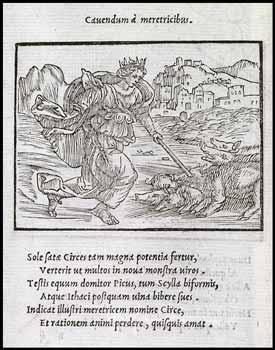Italy, (1492-1550)
Alciato’s emblem books – first Emblematum Liber or Emblemata then Emblematum libellus – set the pattern commonly, though not universally associated with the emblem books.
On a standard page, first is a motto (inscriptio), then a picture (pictura) and finally a verse text or epigram (the subscriptio).
For Circe’s picture, the motto is:
Cavendum à meretricibus.
“Beware of prostitutes.”
The inscription is:
Sole satae Circes tam magna potentia fertur,
Verterit ut multos in nova monstra viros.
Testis equus domitor Picus, tum Scylla biformis,
Atque Ithaci postquam vina bibere sues.
Indicat illustri meretricem nomine Circe,
Et rationem animi perdere, quisquis amat.
“So great, we are told, was the power of Circe, daughter of the Sun, that she turned many persons into new monstrous shapes. A witness to this is Picus, tamer of horses, and Scylla with her double form, and the Ithacans who became pigs after drinking the wine. Circe with her famous name indicates a whore and shows that any man who loves such a one loses his reason.”
About the Artist:
Andrea Alciato, Italian (1492-1550), commonly known as Alciati or Andreas Alciatus), was a jurist and writer. He is regarded as the founder of the French school of legal humanists.
Alciati is most famous for his Emblemata, published in dozens of editions from 1531 onward. This collection of short Latin verse texts and accompanying woodcuts created an entire European genre, the emblem book, which attained enormous popularity in continental Europe and Great Britain.
Some of the various authorized and unauthorized editions of Alciato’s work have been attributed to Hans Schaufelein (1483-1539) or Jean “Mercure” Jollat (fl. 1492-1545). Also, individual devices may also have been revised over subsequent editions, or replaced. But this Aldine edition of 1546 remains without any definitive identification of the artist who designed and exicuted the devices. [DES-10/14]

